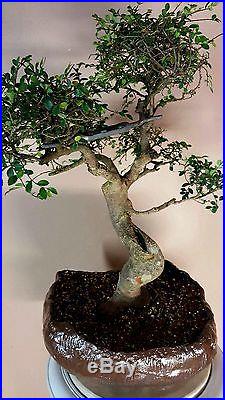
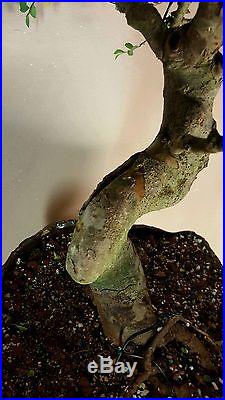
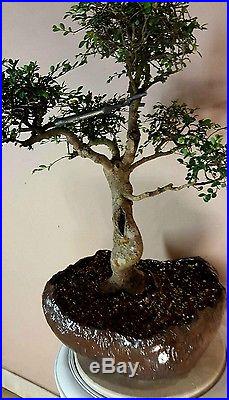
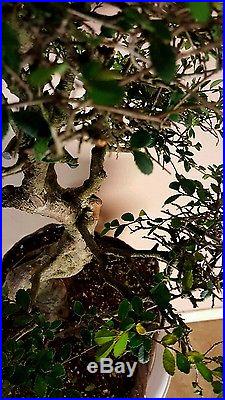
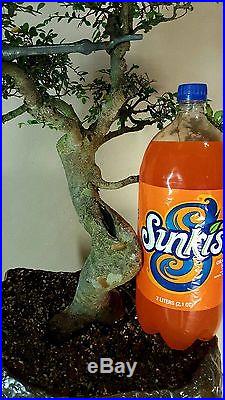
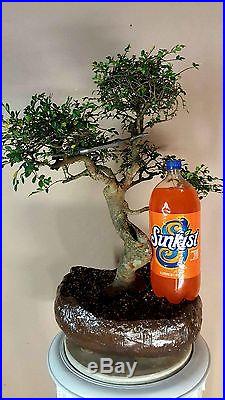
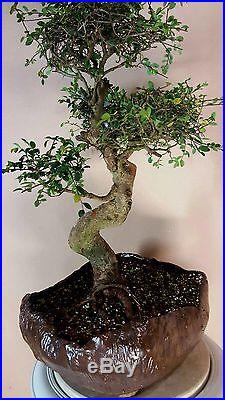
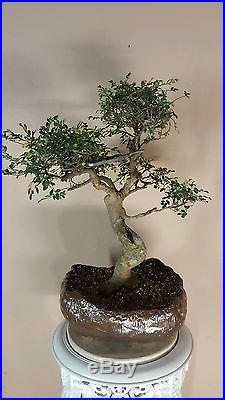
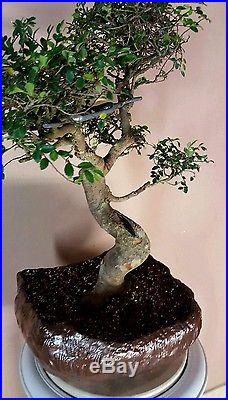
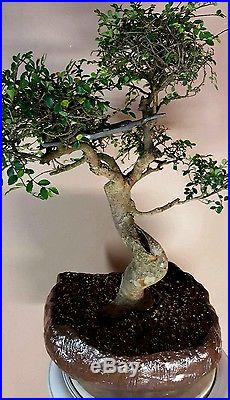
IMPORTED 7 YEARS AGO pedestal Not included. This picture does not do my tree any justice but I tried capturing front back and side to side for your viewing. Please refer to the 2-liter Sunkist for size comparisons. The Chinese Elm (Ulmus parvifolia) is endemic to south-east Asia and especially China. In its home countries it can become a mighty tree up to 25 m tall and with 1 m trunk diameter. The Chinese Elm develops a fine ramification and small leaves very easily which makes it a very good bonsai plant. The Elm is often confused with the Zelkova but if you compare their leaves the difference is clearly recognizable. The Chinese Elm is the most popular. Specific Bonsai care guidelines for the Chinese Elm bonsai Position: The Chinese elm grows well in full sun and also in partial shade. In mild climates it can stay outside during the winter. A Chinese Elm bought as an indoor bonsai can be placed outside during the summer and in winter it is best to take it into a cold frost-free room. Chinese Elms can usually endure some frost but it seems that it differs depending on the region it was imported from (This ones from Japan styled in USA By RamCa Bonsai). Trees from northern Chinese regions seem to be more frost-hardy that those from southern areas. Depending on the temperatures of their winter quarters Chinese Elms can either drop their leaves or keep them until spring when the new shoots emerge. Watering: The Chinese Elm must be watered generously as soon as the soil gets dry. Drought should be avoided as well as permanent wetness. Feeding: During the growing season the Chinese Elm should be fed well. It doesn’t require very special fertilizer. A combination of solid organic fertilizer and a well-balanced liquid chemical product is a good concept. When the elm is in a cold place in winter it should not be fed during dormancy. Pruning: If you let the Chinese Elm grow freely it will thicken rapidly. It responds well to frequent trimming which produces a dense ramification and it also buds well from old wood after strong pruning. Allow shoots to extend to 3 or 4 nodes and then prune back to 1 or 2 leaves. A good time for pruning large branches of the Chinese elm is late autumn. The elm can be shaped very well with normal wiring and guy wires. Repotting: Younger Chinese Elms should be repotted every two years, older and large specimens can be repotted in longer intervals. Spring is the best time for repotting. Root pruning should be done with precision and as the Chinese Elm tends to produce crooked and intertwined roots you should work on them very carefully in order to create a regular nebari as good as possible. The Chinese Elm has no special requirements concerning the soil, but it should be well-drained. A standard soil mixture can be used. Propagation: Chinese Elm Bonsai trees can be propagated by cuttings without problems usually. Propagation by seeds is less recommendable. Pests and diseases: Often the Chinese Elm is infested by spider mites or scale when humidity is low. Appropriate pesticides should be used and frequent spraying with water might help additionally. Spraying with thinned lime-sulfur or systemic pesticides can make the Chinese Elm drop all its leaves, so avoid these products. The item “Specimen Large Imported Formal Style Chinese Elm Bonsai Tree, custom Bonsai pot” is in sale since Tuesday, April 26, 2016. This item is in the category “Home & Garden\Yard, Garden & Outdoor Living\Plants, Seeds & Bulbs\Plants & Seedlings\Bonsai”. The seller is “ramirolicea” and is located in Miami, Florida. This item can be shipped to United States.
Tags: bonsai, chinese, custom, formal, imported, large, specimen, style, tree





















0